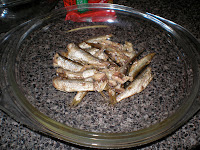Friday
Step 1: I made the duxelles, a finely chopped and then sauteed mixture or mushrooms, garlic, shallots, and thyme. Thank goodness for the food processor, otherwise I would have been chopping those mushrooms all day.
Step 2: Making the 'veal stock' for the mushroom gravy. I couldn't find any veal bones at the grocery store, so ours was doctored up beef stock. I still chopped the carrot, onion, and celery and roasted them and then simmered it all in (no salt added) beef stock and red wine. We keep a container of leftover red wine in our freezer for times when recipes call for it, but we don't want to open a bottle.
 |
| Mom and I also made brownies |
Step 3: Ryan seared the Beef tenderloin. (Our cut of meat was not quite what the recipe called for and it still had the silver skin on it. I highly recommend you get it cut off if you attempt this recipe).
Step 4: We shingled the prosciutto onto cling wrap, and spread the duxelles on-top. The beef was then slathered in black truffle butter and rolled up inside the prosciutto. This was then set to rest in the refrigerator for 30 minutes.
Meanwhile... I was also making roasted potatoes.
Step 5: The beef came out of the fridge and was wrapped in puff pastry. We thought we might not have enough, but with a coaxing we stretched it out. The whole thing went into the oven for 45 minutes and came out looking and smelling incredible.
Step 6: I finished making the mushroom gravy by sauteing mushrooms and shallots in the pan used to sear the beef. I added the stock I made Friday and simmered it for 10 minutes. I'm not a huge gravy fan, but after one bite decided I could eat this for breakfast, lunch, or dinner. I might even embrace our current southern situation and try it over biscuits... I could drink it, it's that good.
We topped our dinner off with steamed green beans, which were tasty on their own, but even better with a little gravy on them. Overall this is probably the finest meal we have ever created, and one of the best I've ever eaten. I thought about figuring the calorie content, but decided I would drive myself nuts trying. According to FitDay.com a serving of Beef Wellington has 354 calories, 22g fat, 11g carb, and 25g protein. But they do not give a recipe so it's hard to say how that compares to ours.
This was a good instance of how cooking at home can save you money. Overall, this meal cost between $75-$100 to prepare. (I added in a few cents here and there for all the oil, salt, pepper, potatoes, green beans...) Per person that is $12.50-$16.60 figuring that it serves 6 people. in an upscale restaurant this could easily have cost $21 or more. Ryan found a restaurant in NYC that will serve a three course meal for $75, but adds $8 if you want the Beef Wellington.
We all agreed that we would make Beef Wellington again, but not for quite some time.









































